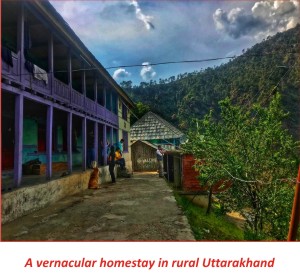|
The Joy of Slow Travel The Himalayan ranges are home to several secluded communities, their isolation having given them a unique way of life and a hitherto little understood way of living with nature. Today, rather than looking for unbridled luxury, more and more people travel to experience living cultures. Staying with hardened highland families in their homesteads and alpine huts on remote mountain ridges is an experience a traveller is unlikely to forget in a lifetime. In a state like Uttarakhand, where we work, over 3,500 villages are either abandoned or on the verge of abandonment by people migrating to the plains looking for jobs. Conditions in other hill states is no better. These migrants leave behind beautiful vernacular homes and pristine landscapes, looking for jobs in polluted and dehumanised cities.
‘Been There, Doon That’ is a voluntary group
based in Dehra Dun working with communities developing a unique model of
sustainable and slow tourism. We work with hill communities to reverse
the trend of out-migration. Local architecture and a strong will within
the community to develop slow and ecologically sustainable tourism are
essentials. This group has been converting simple village folk into eco-preneurs
by engaging with community villages in the hills that are situated off
the highways and those that can be approached through short walking
tracks.
Himalayan villages are usually base camps for treks and hikes and we train local youth to be walk and trail leaders. Besides adventure, we also develop local skills in conducting heritage walks, moth, bird, fern, tree, wildlife and butterfly trails. Conducting these walks makes locals appreciative of their own natural wealth and the need to protect the same. Thus, for a traveller seeking a memorable homestay experience, it is essential to approach a community as a learner, be willing to step out of one’s comfort zone and experience an alternate lifestyle and worldview. We encourage visitors to engage in community work like weeding fields, making dung cakes and grazing sheep. We often challenge visitors to live with communities and imbibe their way of life, preparing them to resist the urban temptations of packaged food, bottled water or hot showers. After all, what is the point of a holiday if it is experienced at the same pace as your regular life? We discourage camping, ensuring that travellers stay in chanis—small village homes in fields or huts of the transhumant Gujars. We ask tourists to sample the local cuisine and participate in village rituals. Once you experience that languid pace of community life and the complete absence of individualism, you return home a different person. That, according to me, lies at the core of a successful homestay. Our model is based on slow tourism. The idea of homestays was born out of the idea of slow travel, and we started about two years ago when we began leading heritage walks to distant villages. We were struck by how different life and its daily routines were as compared to our own lives in urban sprawls. Our experience tells us that for homestays to be successful representations of a distinctive micro-culture, the community must desist from making any alterations to their vernacular homes. We have come across government and professional travel agencies often adding ‘comforts’ to these abodes, or attempting to make them more ‘hygienic’, thereby severely diluting the authenticity of experience for a visitor. While it is a challenge for communities to pick and choose sensitive and sensitised visitors, it is incumbent upon the traveller to respect local customs. On a slow travel vernacular homestay tour, travellers must surrender their ego and prepare to be one with the elements. It is a lesson in how one can live with so little in terms of worldly possessions. One returns with the knowledge of trees and herbs, birding and entomology, and maybe a Pahadi recipe or two. Or one learns to meditate sitting on a rock under the Deodars (the tree that is ambrosia for the Gods) or bask in the sun while watching insects frolic in the grass. ■
Lokesh Ohri
|
